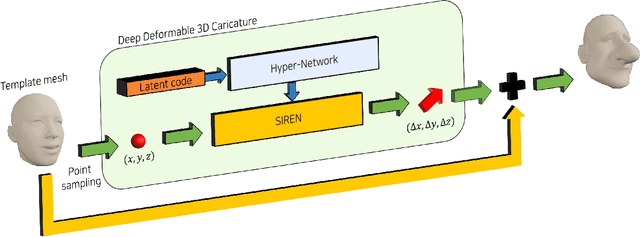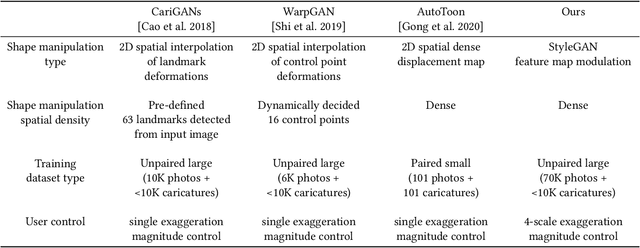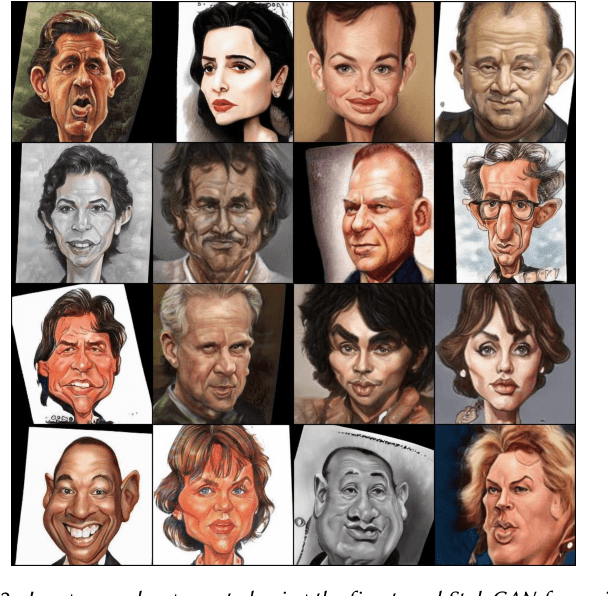Yucheol Jung
Discontinuity-preserving Normal Integration with Auxiliary Edges
Apr 04, 2024Abstract:Many surface reconstruction methods incorporate normal integration, which is a process to obtain a depth map from surface gradients. In this process, the input may represent a surface with discontinuities, e.g., due to self-occlusion. To reconstruct an accurate depth map from the input normal map, hidden surface gradients occurring from the jumps must be handled. To model these jumps correctly, we design a novel discretization scheme for the domain of normal integration. Our key idea is to introduce auxiliary edges, which bridge between piecewise-smooth patches in the domain so that the magnitude of hidden jumps can be explicitly expressed. Using the auxiliary edges, we design a novel algorithm to optimize the discontinuity and the depth map from the input normal map. Our method optimizes discontinuities by using a combination of iterative re-weighted least squares and iterative filtering of the jump magnitudes on auxiliary edges to provide strong sparsity regularization. Compared to previous discontinuity-preserving normal integration methods, which model the magnitudes of jumps only implicitly, our method reconstructs subtle discontinuities accurately thanks to our explicit representation of jumps allowing for strong sparsity regularization.
Mesh Density Adaptation for Template-based Shape Reconstruction
Jul 30, 2023Abstract:In 3D shape reconstruction based on template mesh deformation, a regularization, such as smoothness energy, is employed to guide the reconstruction into a desirable direction. In this paper, we highlight an often overlooked property in the regularization: the vertex density in the mesh. Without careful control on the density, the reconstruction may suffer from under-sampling of vertices near shape details. We propose a novel mesh density adaptation method to resolve the under-sampling problem. Our mesh density adaptation energy increases the density of vertices near complex structures via deformation to help reconstruction of shape details. We demonstrate the usability and performance of mesh density adaptation with two tasks, inverse rendering and non-rigid surface registration. Our method produces more accurate reconstruction results compared to the cases without mesh density adaptation.
Deep Deformable 3D Caricatures with Learned Shape Control
Jul 29, 2022



Abstract:A 3D caricature is an exaggerated 3D depiction of a human face. The goal of this paper is to model the variations of 3D caricatures in a compact parameter space so that we can provide a useful data-driven toolkit for handling 3D caricature deformations. To achieve the goal, we propose an MLP-based framework for building a deformable surface model, which takes a latent code and produces a 3D surface. In the framework, a SIREN MLP models a function that takes a 3D position on a fixed template surface and returns a 3D displacement vector for the input position. We create variations of 3D surfaces by learning a hypernetwork that takes a latent code and produces the parameters of the MLP. Once learned, our deformable model provides a nice editing space for 3D caricatures, supporting label-based semantic editing and point-handle-based deformation, both of which produce highly exaggerated and natural 3D caricature shapes. We also demonstrate other applications of our deformable model, such as automatic 3D caricature creation.
StyleCariGAN: Caricature Generation via StyleGAN Feature Map Modulation
Jul 09, 2021



Abstract:We present a caricature generation framework based on shape and style manipulation using StyleGAN. Our framework, dubbed StyleCariGAN, automatically creates a realistic and detailed caricature from an input photo with optional controls on shape exaggeration degree and color stylization type. The key component of our method is shape exaggeration blocks that are used for modulating coarse layer feature maps of StyleGAN to produce desirable caricature shape exaggerations. We first build a layer-mixed StyleGAN for photo-to-caricature style conversion by swapping fine layers of the StyleGAN for photos to the corresponding layers of the StyleGAN trained to generate caricatures. Given an input photo, the layer-mixed model produces detailed color stylization for a caricature but without shape exaggerations. We then append shape exaggeration blocks to the coarse layers of the layer-mixed model and train the blocks to create shape exaggerations while preserving the characteristic appearances of the input. Experimental results show that our StyleCariGAN generates realistic and detailed caricatures compared to the current state-of-the-art methods. We demonstrate StyleCariGAN also supports other StyleGAN-based image manipulations, such as facial expression control.
* Accepted to SIGGRAPH 2021. For supplementary material, see http://cg.postech.ac.kr/papers/2021_StyleCariGAN_supp.zip
 Add to Chrome
Add to Chrome Add to Firefox
Add to Firefox Add to Edge
Add to Edge